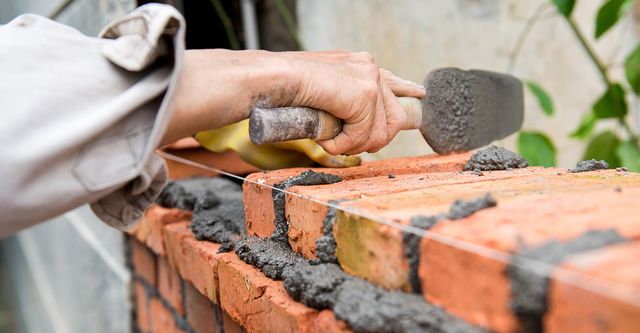Arrange a Chimney Sweep Today for a Tidy and Safe Fire Place
Arrange a Chimney Sweep Today for a Tidy and Safe Fire Place
Blog Article
Opening the Tricks of Lasting Stonework Building And Construction Practices for Eco-Friendly Buildings
Among the myriad methods to eco-friendly structure, lasting stonework construction stands out as a reliable and long lasting approach that holds a wide range of untapped potential. From the choice of materials to cutting-edge construction techniques, the tricks to accomplishing sustainability within stonework building and construction are diverse and appealing.
Advantages of Sustainable Stonework Building And Construction
Welcoming sustainable masonry construction methods not only minimizes environmental influence but likewise offers long-term financial advantages to home builders and areas. By making use of products like recycled bricks, obstructs, and stones, building contractors can considerably lower the carbon footprint of their tasks while advertising resource efficiency. In addition, sustainable stonework construction strategies, such as correct insulation and thermal mass properties, can boost power performance within structures, leading to lowered functional costs gradually.
In addition, the durability and strength of masonry structures add to lasting financial advantages. Buildings constructed using lasting masonry methods often require less repair and maintenance, equating to cost financial savings for contractors and residential or commercial property proprietors. The durability of masonry materials also guarantees that frameworks remain secure and safe, reducing the need for regular restorations or substitutes.
Eco-Friendly Masonry Materials
Making use of environment-friendly stonework products is an essential action in the direction of improving the sustainability of construction techniques and minimizing environmental effect while maximizing long-term financial benefits. Sustainable masonry materials are sourced, created, and utilized in a fashion that lowers overall ecological effect. Materials such as recycled bricks, reclaimed rock, and lasting cinder block are becoming progressively popular choices for eco-conscious builders. Recycled blocks, for instance, not only divert waste from land fills yet likewise need less power to produce compared to new bricks. Reclaimed stone supplies an unique aesthetic appeal while reducing the need for brand-new quarrying. Sustainable concrete blocks include recycled accumulations and may feature improved insulation homes, adding to energy performance in structures.
In addition, all-natural materials like adobe, rammed earth, and straw bales give exceptional thermal mass properties, lowering the demand for heating and cooling energy. These materials are often locally offered, advertising regional economies and minimizing transportation-related carbon discharges. By picking environment-friendly stonework materials, building projects can dramatically minimize their ecological footprint and add to the production of much healthier, much more lasting built environments.
Energy-Efficient Masonry Strategies
Energy efficiency plays a critical role in boosting the sustainability of stonework building practices. By executing energy-efficient stonework techniques, contractors can dramatically lower the total energy intake of a building, causing reduced functional expenses and a smaller ecological footprint. One crucial energy-efficient stonework technique is making use of thermal mass, which includes including thick products like concrete or block right into the structure's framework to take in and save warm. This assists control indoor temperature levels, minimizing the demand for mechanical home heating and cooling systems.

Developments in Lasting Stonework
Current innovations in lasting masonry practices have actually caused ingenious techniques that are reshaping the building and construction market. One such technology is the advancement of self-healing concrete, which uses germs installed within the concrete to recover splits autonomously. This advancement not just minimizes upkeep prices but also improves More hints the longevity of masonry link structures, adding to their sustainability.
One more notable development is using recycled aggregates in masonry construction - masonry contractor. By incorporating materials such as smashed ceramic waste or recycled glass into concrete blends, building contractors can reduce the environmental impact of building jobs while maintaining architectural honesty. This technique not only draws away waste from land fills yet likewise saves natural deposits, making it a crucial improvement in sustainable stonework construction
Moreover, the integration of electronic style tools, such as Structure Information Modeling (BIM), is revolutionizing the means masonry structures are prepared and constructed. BIM permits for even more exact estimations, minimized product wastefulness, and enhanced power efficiency, inevitably leading to more sustainable structure methods. These technologies jointly indicate an appealing future for sustainable masonry construction in the period of environmentally friendly structures.
Future Trends in Masonry Sustainability
With the ingenious strides made in lasting masonry methods, the future trends in stonework sustainability are positioned to additional change the construction sector. Among the key trends forming the future of stonework sustainability is the boosted assimilation of innovation. Advancements such as Building Details Modeling (BIM) and digital fact simulations are being used to enhance stonework construction processes, resulting in reduced product waste and improved energy performance in structures.
Furthermore, the growth of unique sustainable materials is set to play a substantial function in enhancing the eco-friendliness of masonry construction. masonry contractor. Advancements like self-healing concrete, recycled aggregates, and bio-based binders are getting traction for their capability to decrease environmental influence while maintaining structural integrity

Conclusion
In verdict, sustainable masonry important source building practices supply numerous advantages for green buildings. By using environmentally friendly products and energy-efficient strategies, masonry can add to a much more sustainable built environment. Developments in lasting masonry are constantly being created to even more enhance the ecological performance of buildings. Looking in the direction of the future, the pattern of masonry sustainability is anticipated to grow, causing even more eco-friendly and energy-efficient building techniques in the years to come.
Report this page